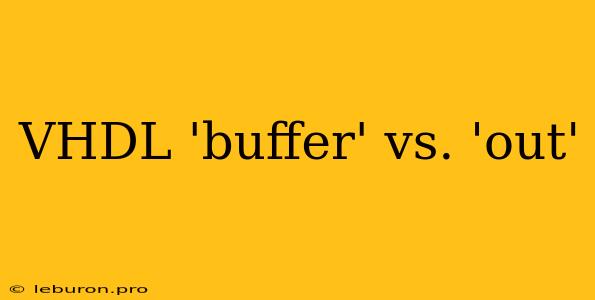In the world of hardware description languages (HDLs) like VHDL, understanding the nuances of signal assignments and port declarations is crucial for designing efficient and functional digital circuits. Two common constructs that often lead to confusion are the 'buffer' and 'out' keywords. While both deal with signal outputs, they differ in their fundamental behavior and applications, particularly in the context of signal propagation and bi-directional communication. This article aims to clarify the distinctions between 'buffer' and 'out' in VHDL, exploring their functionalities, advantages, and limitations through illustrative examples.
Understanding the 'out' Port
The 'out' keyword is the most fundamental and commonly used declaration for output ports in VHDL. It defines a unidirectional signal flow, where data is exclusively transmitted from the entity or component to the external environment. This means the external circuit can only receive data from the 'out' port and cannot actively influence its value.
entity Example_Out is
Port (
input_signal : in std_logic;
output_signal : out std_logic
);
end entity;
architecture Behavioral of Example_Out is
begin
output_signal <= input_signal;
end Behavioral;
In this example, 'output_signal' is declared as an 'out' port. The process inside the architecture assigns the value of 'input_signal' to 'output_signal'. This establishes a unidirectional data flow, allowing 'input_signal' to influence the value of 'output_signal' but not vice versa.
The Role of 'buffer' in VHDL
The 'buffer' keyword in VHDL, on the other hand, acts as a signal driver, effectively creating a dedicated output signal that directly reflects the value of a source signal. It allows for signal propagation and can be used for scenarios where a single input signal needs to be driven to multiple destinations.
entity Example_Buffer is
Port (
input_signal : in std_logic;
output_signal_1 : buffer std_logic;
output_signal_2 : buffer std_logic
);
end entity;
architecture Behavioral of Example_Buffer is
begin
output_signal_1 <= input_signal;
output_signal_2 <= input_signal;
end Behavioral;
In this example, 'output_signal_1' and 'output_signal_2' are declared as 'buffer' ports. They both directly reflect the value of 'input_signal'. This allows for driving the same signal to multiple destinations, ensuring consistent signal values across different parts of the circuit.
Key Differences Between 'out' and 'buffer'
-
Signal Flow Direction: The 'out' keyword denotes unidirectional signal flow, with data flowing only from the component to the outside world. The 'buffer' keyword, however, enables a special type of bidirectional flow, where the 'buffer' acts as a driver, replicating the value of the input to the output.
-
Signal Assignment: With 'out' ports, the internal process assigns a value to the 'out' signal. The 'buffer' keyword does not require an explicit assignment. Instead, the 'buffer' signal automatically reflects the input signal's value.
-
Multiple Destinations: The 'out' keyword cannot be used to drive multiple destinations simultaneously. To achieve this, multiple instances of the component with different 'out' ports can be used. The 'buffer' keyword allows for driving the same signal to multiple destinations, eliminating the need for multiple instances.
-
Signal Driving Strength: The 'out' keyword does not inherently indicate the driving strength of the signal. The driving strength is determined by the internal logic of the component. The 'buffer' keyword, however, explicitly denotes a strong driving strength, ensuring that the signal value is propagated to multiple destinations without loss.
When to Use 'buffer' vs. 'out'
-
Unidirectional Output: Use the 'out' keyword when the signal flow is strictly unidirectional, meaning the external circuit only receives data from the component. This is the most common scenario for simple data transmission.
-
Signal Propagation: Use the 'buffer' keyword when you need to drive a single input signal to multiple destinations, ensuring consistent values across those destinations. This is beneficial for fan-out scenarios where the same signal is required in different parts of the circuit.
-
Signal Buffering: Use the 'buffer' keyword when you want to explicitly define a strong driving strength for a signal, particularly when it needs to drive multiple high-impedance loads or ensure reliable propagation through long wires.
Practical Examples
-
Simple Data Transmission: Consider a component that generates a clock signal. The clock signal output would be declared as an 'out' port, as the external circuit only needs to receive the clock signal.
-
Multiple Data Receivers: Imagine a component that generates a data signal used by multiple subsystems within the design. Using the 'buffer' keyword for the data signal output enables driving the same signal to all subsystems, ensuring synchronized data access.
-
Signal Isolation: The 'buffer' keyword can also be used for signal isolation. If you need to isolate a particular signal from potential conflicts or unintended driving, a 'buffer' can be used to create a separate instance of the signal, effectively buffering the original signal and preventing unwanted interactions.
Conclusion
Understanding the differences between 'buffer' and 'out' in VHDL is crucial for designing efficient and reliable digital circuits. While both keywords deal with signal outputs, their functionality, application scenarios, and impact on signal propagation differ significantly. By carefully choosing the appropriate keyword based on the intended application and design requirements, you can ensure the seamless flow of signals within your VHDL design. As you navigate the complexities of VHDL, remember that mastering these fundamental concepts is essential for achieving optimal performance and achieving the desired behavior in your digital circuits.
